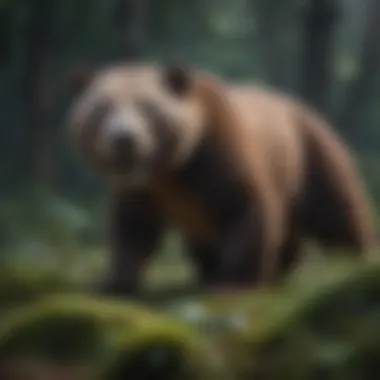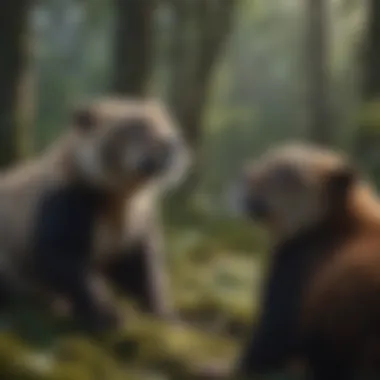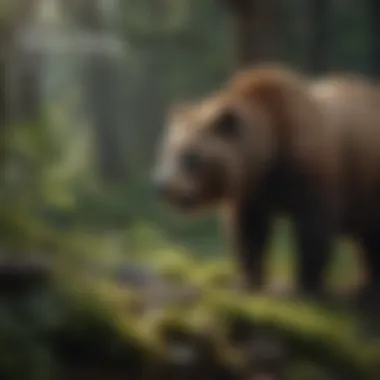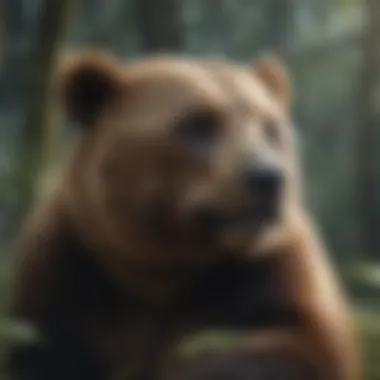Endangered Species Scale: Understanding Biodiversity Loss


Intro
In an age where biodiversity is rapidly declining, understanding the Endangered Species Scale becomes pivotal. This scale acts as a compass in navigating the complex landscape of conservation, showing not just which species are at risk but also why their survival matters. While it may sound technical, the implications of this scale resonate deeply with the health of our ecosystems and, by extension, our own well-being.
The endangered species scale isn’t a one-size-fits-all model; it has layers of depth that unfold when we analyze its components. This article seeks to dissect these layers, shedding light on the classifications that inform our conservation strategies and what they reveal about human impacts on vulnerable species.
Research Overview
Summary of Key Findings
Through this inquiry, several critical insights into the endangered species scale emerge:
- Classification Criteria: The criteria used for classifying species in danger varies significantly and considers factors like population size, habitat loss, and the threats posed by human activities.
- Conservation Strategies: Various effective strategies target at-risk species, emphasizing the role of protected areas and legal frameworks.
- Human Activity Links: The scale serves to illustrate how our actions can lead to extinction, making the urgency of awareness and policy implementation palpably clear.
Background and Context
Historically, the classification of endangered species dates back to efforts in the 20th century when the realization struck that biodiversity was not just a luxury but a necessity. The International Union for Conservation of Nature (IUCN) developed a Red List that has become an authoritative guide for assessing the risk levels of species globally. Factors such as climate change, habitat destruction, and overexploitation have since emerged as principle threats.
The decline of specific species acts as a siren call, signaling the ecological shifts we must urgently address. Without dedicated conservation efforts, the chain reaction of losing one species can lead to the collapse of entire ecosystems. For instance, when the Passenger Pigeon went extinct in the early 20th century, it was a stark reminder of how human choices drastically affect nature.
"Biodiversity is the cornerstone of life, and its loss can lead to unforeseen consequences in the chain of life itself."
Moving forward, it’s essential to decode the intricacies of the endangered species scale. By doing so, we unveil not only the state of our planet but the pressing motivations for sustainable practices across our societies. Each classification in this scale tells a story—of survival, struggle, and the imperative to foster relationships that support our earth's intricate web of life, rather than unravel it.
Understanding the Endangered Species Scale
Understanding the Endangered Species Scale is not just a matter for wildlife enthusiasts or conservationists; it’s a crucial discourse that circles back to our collective responsibility toward preservation of biodiversity. The implications of this scale extend beyond academic corridors into the very fabric of ecological balance and human existence. This section digs into what the Endangered Species Scale means, why it matters, and how it serves as a bedrock for conservation efforts around the globe.
Definition and Importance
The Endangered Species Scale is essentially a framework used to categorize various species based on their risk of extinction. This classification plays a significant role in prioritizing resources and strategic conservation initiatives. To put it simply, it acts like a tallied warning sign indicating which species need immediate attention and which pose a less urgent concern.
Importance of the Scale:
- Guiding Conservation Efforts: It helps direct funding and research efforts towards species that need it the most, ensuring that conservationists are not just throwing spaghetti at the wall to see what sticks.
- Raising Awareness: The classifications promote societal awareness about the condition of flora and fauna, driving home the point that the loss of one species can lead to a domino effect in the ecosystem.
- Policy Implementation: It aids governments and organizations in establishing laws and regulations that serve to protect endangered species from human-induced threats.
Understanding the nuances of this scale can help people appreciate the luck that certain species still have, while also recognizing that more than just numbers are at stake; it’s a matter of life and death for countless organisms.
Historical Context
The historical context of the Endangered Species Scale reveals a tale of evolution not just in scientific understanding, but in societal attitudes towards nature itself. Back in the 20th century, the field of conservation began to burgeon as species started to dwindle at an alarming rate. The awareness grew that unchecked human activities could disrupt the delicate thread of life.
In 1966, the U.S. government took a monumental step by passing the Endangered Species Preservation Act. This was a watershed moment that recognized the gravity of species loss and established a legal framework to combat it. However, it was the 1973 Endangered Species Act that cemented the baseline for the protection structure we see today. This legislation didn't just throw a life raft to struggling species; it also set a precedent on how globally species conservation should be taken seriously.
In this evolving scenario, various organizations like CITES emerged to take a global stance, ensuring that the cries for help from the dwindling species would not fall on deaf ears. Tracking these updates helps create a coalition of knowledge that underscores the importance of what this scale represents.
As we reflect on history, we can argue that understanding the Endangered Species Scale is about learning from the past. Knowing where we’ve stumbled can give us better footing as we navigate future paths to biodiversity conservation.
"An ounce of prevention is worth a pound of cure"— It rings painfully true when talking about endangered species.
Criteria for Endangered Species Classification
Understanding the criteria used for classifying endangered species is essential because it influences conservation policies and practices worldwide. The classification affects which species receive protections, funding, and research attention. It also helps raise public awareness about biodiversity and the need for conservation efforts. When we grasp the criteria, we can better appreciate the urgent need for action in safeguarding our planet's diverse life forms.
Population Size and Trends
Population size is a critical factor in assessing a species' risk level. Specifically, a dwindling population signals a potential endangerment. For instance, the Sumatran orangutan has experienced a dramatic decline due to habitat destruction. In 1990, the population was estimated at 12,000; by 2020, it had plummeted to around 14,000. This trend highlights the need to monitor not just the population size, but also its trajectory over time.
A species may not necessarily be considered endangered if the population is stable or growing, even if it is relatively small. However, if analyses reveal a consistent downward trend over multiple generations, that signals immediate cause for concern. Keeping a pulse on populations allows conservationists to act swiftly before it's too late.
Geographic Range and Habitat
The reach of a species—its geographic range—plays a pivotal role in determining vulnerability. A limited range means that a species may be more susceptible to localized threats. Take the Vaquita porpoise as an example; it is found exclusively in the northern part of the Gulf of California. With its range restricted to this small area, it is particularly vulnerable to human activities like fishing and pollution.
In addition to geographic range, the quality of habitat is paramount. Factors such as fragmentation and degradation can severely impact a species' survival. The Amur leopard, for example, inhabits a region in the Russian Far East and northeastern China. The loss of its habitat due to urban development and poaching has led to its classification as critically endangered. Maintaining habitat quality is intimately connected to preserving the delicate balance necessary for various species to thrive.


Threat Level Assessment
Assessing the threats faced by a species is a complex but essential part of the classification process. It covers various factors, including habitat loss, poaching, climate change, and invasive species. Each of these threats can cause significant declines in population or range.
When evaluating threats, we should also consider the immediacy and severity of these impacts. For instance, with overexploitation, a species might be under constant pressure from hunting for bushmeat or illegal wildlife trade. Similarly, climate change poses long-term risks that could alter habitats and food availability drastically.
The IUCN Red List serves as a benchmark in threat assessment, providing a framework for categorizing species risk based on estimated impact. Conservationists use this list to prioritize actions, directing resources to species facing the starkest threats.
"Understanding the criteria for endangered species classification is the first step in framing effective conservation strategies. Focused efforts can lead to substantial results, but we must first know what we're up against."
Ultimately, the criteria used for classifying endangered species shed light on the challenges that various species face, guiding advocacy and action strategies necessary to combat this ongoing crisis.
International Frameworks and Policies
Understanding international frameworks and policies is crucial for dismantling the complicated tapestry of conservation efforts across the globe. These frameworks act as blueprints for governing bodies, organizations, and individual conservationists alike, providing guidelines on how to protect endangered species and preserve biodiversity. They set the stage not only for local practices but also for global cooperation in addressing the looming threats posed by extinction. Different agreements and laws aim to showcase the interconnectedness of ecological systems and human interactions, presenting a clearer picture of the collective efforts needed from various stakeholders. \n\nSome notable points include:
- Establishing legal protections for endangered species.
- Promoting collaborative international research and sharing of resources.
- Heightening awareness regarding the challenges of biodiversity loss.
These frameworks emphasize that no single country can combat biodiversity loss in isolation; it requires a concerted global effort.
Convention on International Trade in Endangered Species (CITES)
CITES stands as a pivotal piece in the international conservation puzzle, functioning as a legal framework designed to regulate international wildlife trade. The significance of CITES lies not only in its role as a treaty but also in the affirmative actions it mandates to ensure that trade does not threaten the survival of species in the wild.
Founded in 1973, CITES has been crucial in addressing the excessive exploitation of certain species caused by demand for products derived from them. The treaty categorizes species into three appendices based on their conservation status and the degree of protection they require:
- Appendix I includes species threatened with extinction, offering them the highest level of protection. International trade in these species is generally prohibited, except under exceptional circumstances.
- Appendix II consists of species that are not necessarily currently threatened with extinction but may become so unless trade is strictly regulated.
- Appendix III contains species that are protected in at least one member nation, which has asked other nations for assistance in controlling the trade of that species.
With over 180 countries as parties, CITES exemplifies broad international commitment. However, its effectiveness hinges on how well signatory countries enforce the regulations at their borders, often stumbling over issues of corruption and resource limitations.
"CITES represents a lifeline for many species, but without strong adherence from member countries, its impact can dwindle."
Endangered Species Act (ESA)
In the United States, the Endangered Species Act of 1973 serves as a cornerstone for national conservation efforts, aiming to protect species at risk of extinction. The ESA is not merely a bureaucratic apparatus but a robust legal framework that embodies a profound commitment to the idea that biodiversity has intrinsic value and that humans hold a responsibility to safeguard it.
The Act lays out the process for classifying species based on their risk level, offering protections against habitat destruction and mitigating potential harm through various strategies. Significant elements of the ESA include:
- Listing species as endangered or threatened based on scientific assessment of their populations and habitats.
- Development of recovery plans that outline targeted actions to bring species back from the brink of extinction.
- Consultation requirements that mandate federal agencies to consider the act's implications in their planning.
However, challenges remain. Opposition to the ESA often stems from economic interests and local governance issues, which may peddle the narrative that conservation can impede development. Nevertheless, success stories emerge from the ESA’s implementation, showcasing how concerted legal efforts can indeed make a difference. The recovery of the Bald Eagle and the California Condor exemplifies the transformative impact such legislation can yield.
In the scope of international frameworks, both CITES and the ESA are instrumental in navigating the complexities of conservation and exemplifying the necessity of unified action to combat biodiversity loss.
Critically Endangered Species Case Studies
In addressing the crisis of biodiversity loss, case studies of critically endangered species serve an invaluable purpose. They not only reveal the pressing challenges faced by these species but also showcase the multifaceted efforts aimed at their conservation. By examining specific examples like the Sumatran orangutan, vaquita porpoise, and Amur leopard, we can glean insight into the broader themes of habitat preservation, human impact, and the need for urgent action. These case studies underscore how localized tragedies can resonate globally, and they are a rallying point for conservationists and policymakers alike.
Sumatran Orangutan
The Sumatran orangutan (Pongo abelii) is a flagship species for tropical rainforest conservation. Found only on the Indonesian island of Sumatra, this ape has seen its population decline drastically due to deforestation, primarily for palm oil plantations. As of the latest estimates, only about 14,000 of these unique primates remain in the wild.
The plight of the Sumatran orangutan highlights the intertwined nature of conservation efforts and human economic activities. Critics often point to the palm oil industry as a significant threat, with farming practices leading to habitat fragmentation. Notably, orangutans require large territories to thrive, making them particularly vulnerable when forests are cleared.
Efforts to protect them involve setting up protected areas and raising awareness about sustainable alternatives to palm oil. While these initiatives are promising, there remains a long road ahead. As we consider the future of the Sumatran orangutan, it acts as a stark reminder of the balance between development and conservation.
Vaquita Porpoise
The vaquita porpoise (Phocoena sinus), residing in the Gulf of California, is on the verge of extinction. With an estimated population of less than 30 individuals as of recent surveys, this species epitomizes the dire consequences of illegal fishing practices and habitat destruction. The primary eviscerators of the vaquita are gillnets used for catching totoaba, a fish whose swim bladder is highly prized in traditional Chinese medicine.
"The loss of the vaquita not only impacts marine ecosystems but also serves as a cautionary tale about the consequences of human interference with nature."
Efforts to save the vaquita include banning gillnets and increasing enforcement against illegal fishing. However, the challenges are formidable, given the profound socio-economic issues in the region. Engaging local communities and creating economic alternatives holds promise, but as of now, the situation remains critical. The plight of the vaquita underscores the urgent need for concerted action at multiple levels.
Amur Leopard
The Amur leopard (Panthera pardus orientalis) is one of the rarest big cats on the planet, primarily found in the Russian Far East and Northeast China. With only about 100 individuals left in the wild, its survival is precarious due to habitat loss caused by logging, human encroachment, and poaching. This nocturnal predator needs vast territories with abundant prey to thrive and reproduce.


Conservation strategies for the Amur leopard focus on protected areas and anti-poaching measures. The Land of the Leopard National Park in Russia represents a vital effort to set aside habitats where this leopard can roam freely. Moreover, collaboration with local communities to educate them about the ecological importance of this species is crucial.
The situation of the Amur leopard shows how targeted conservation policies can yield results, but also highlights the ongoing threats posed by human activity. Every success, no matter how small, is a reminder of what is at stake, propelling conservationists to continue their efforts with renewed vigor.
Human Impact on Endangered Species
Understanding how human activities influence endangered species is crucial. The interconnection between human existence and biological diversity is complex, with far-reaching implications. Species struggle for survival amidst habitat destruction, pollution, and unsustainable exploitation—all direct results of human actions. Recognizing these ties enables conservation efforts to be more effective and targeted.
Habitat Destruction
Habitat destruction stands as one of the paramount causes threatening numerous species around the globe. Urban development and agriculture often take precedence over ecosystems, leading to fragmented landscapes where creatures can no longer thrive. Whether it's a bustling city sprawling over forests or agricultural fields replacing wetlands, the consequences are dire. A striking example is the Amazon rainforest, often dubbed the "lungs of the planet." Once a vast sanctuary for countless species, this area has faced relentless deforestation.
As habitats shrink, species lose their shelter and resources. Some species may adapt, but many can't and become vulnerable to extinction. The situation is all the more urgent when considering that some habitats will never return to their former glory even if human pressures decrease. This loss alters the balance of ecosystems, leading to greater risks for other species reliant on these habitats.
Pollution and Climate Change
Pollution permeates our environment in multifarious ways, be it air, water, or soil. Each type of pollution poses unique threats to biodiversity. Take plastic pollution, for example. Sea turtles encounter plastic bags, mistaking them for jellyfish, which can lead to suffocation. Water bodies are often filled with pollutants that disrupt aquatic life. Toxic runoff harms freshwater species, causing population declines and habitat degradation.
Additionally, climate change has tiptoed into the scene, exacerbating existing vulnerabilities. Altered weather patterns consequently shift habitat boundaries. For instance, coral reefs, which serve as crucial biodiversity hotspots, are dying due to rising ocean temperatures and acidity levels. If these trends continue, entire ecosystems may collapse, taking numerous species with them.
Overexploitation
Overexploitation is another serious concern. This phenomenon, often linked with commercial interests, refers to the unsustainable hunting, fishing, and harvesting of species. The practice of overfishing, for instance, has led to significant declines in populations of various finned fish. Tuna fisheries are one such example, where relentless fishing has dwindled their numbers alarmingly.
In the case of wildlife, illegal poaching for ivory, skins, or traditional medicine exacerbates the plight of endangered species. The dark reality is that demand persists—and by continuing these practices without controls, we push many species closer to the brink. Efforts to combat overexploitation must include stricter regulations, better enforcement, and public awareness campaigns to decrease demand for such goods.
"Conservation requires an active understanding of human impact; it cannot be achieved through mere aspiration but must involve concerted efforts to reduce our footprint on the planet."
By delving into these aspects of human interaction with the environment, we uncover a narrative filled with urgency. Addressing habitat destruction, pollution, and overexploitation is vital—not just for the species in peril, but for the health of our planet and future generations. Each thread of human activity weaves into the tapestry of life on Earth, impacting ecosystems and ultimately, our survival.
Conservation Strategies and Their Effectiveness
Conservation strategies are the backbone of efforts aimed at reversing the tide of species extinction. As biodiversity faces escalating threats, understanding the effectiveness of these strategies is crucial for maintaining ecological balance. Implementing robust conservation measures can protect endangered species, restore their habitats, and foster sustainable human-environment interactions. In this context, it is vital to analyze how each strategy not only serves its intended purpose but also how it can be improved upon for greater efficacy.
Protected Areas and Reserves
Protected areas play a significant role in conservation by providing safe havens for numerous species. These designated zones, such as national parks and wildlife reserves, restrict human activities that could endanger the flora and fauna residing therein.
In many cases, these areas serve as critical breeding grounds for endangered species, allowing populations to recover. For instance, the Yellowstone National Park has become a refuge for bison and wolves, which have benefitted from the absence of poaching and habitat degradation. However, while protected areas are undeniably vital, their effectiveness can sometimes be limited by factors such as:
- Inadequate size or connectivity: Smaller parks may not support sustainable populations, and fragmented habitats can hinder animal movement and genetic diversity.
- Insufficient management and resources: Many reserves lack adequate funding, resulting in ineffective enforcement of protection laws.
- Human-wildlife conflict: As communities expand, conflicts between humans and wildlife often arise, leading to retaliatory killings or habitat encroachment.
Because of these challenges, effective management strategies must include ongoing assessments of these areas, involving scientists, community members, and policymakers alike.
Restoration Projects
Restoration projects are vital in bringing habitats back to their original state. This process can include reforestation, wetland rehabilitation, and the removal of invasive species. The ultimate goal here is to reinstate ecological balance, enabling wildlife to thrive once more in regions where they have diminished or vanished entirely.
One notable example is the restoration of the longleaf pine forest ecosystem in the southeastern United States. Once widespread, this habitat has been drastically reduced due to logging and agricultural practices. By implementing controlled burns and selective replanting, organizations have returned parts of this ecosystem to a more natural environment, benefitting numerous species that depend on this habitat.
It’s essential to keep in mind, however, that restoration is not a panacea. The success of such projects depends on:
- Understanding historical ecosystems: Knowing what the area should look like can guide effective restoration.
- Continuous monitoring and adaptation: Restoration is an ongoing process. It requires regular assessments to tweak strategies and understand the changing dynamics of the environment.
- Community engagement: Involving local communities ensures that restoration efforts align with human needs and fosters a sense of ownership.
Community Involvement and Education
Engaging local communities and raising ecological awareness is a cornerstone of any successful conservation strategy. Without the support of the people living near endangered species habitats, even the best-laid plans could fall flat. Community involvement can manifest in various forms, including:
- Participatory conservation programs: Local residents can take part in planning and implementing conservation initiatives, ensuring that their knowledge and needs are included.
- Education and outreach: Public awareness campaigns can inform and inspire communities about the importance of conserving biodiversity. For example, workshops or school programs can equip younger generations with the tools to advocate for and protect their environment.
- Alternative livelihoods: Introducing sustainable economic activities, like eco-tourism or organic farming, reduces pressure on wildlife and encourages local benefit from conservation efforts.
Furthermore, promoting respect and understanding of wildlife can lead to a decrease in poaching and habitat destruction.
"Conservation is a state of harmony between men and land." – Aldo Leopold
By working together and fostering educational initiatives, communities become stewards of their environment, which is critical for the long-term success of conservation strategies. In sum, effective conservation requires a multi-faceted approach that combines protected areas, restoration efforts, and an engaged citizenry to protect endangered species and their habitats.


Role of Technology in Conservation
The integration of technology in conservation efforts has transformed the approach towards protecting endangered species. In a world where human impact is significant, innovative tools provide critical data and insights that can greatly assist in safeguarding biodiversity. The use of technology not only enhances awareness but also aids in decision making, allowing conservationists to focus their resources more effectively. Whether it's through real-time data collection or advanced modeling techniques, technology offers a range of benefits that can be harnessed to combat the ongoing crisis of species extinction.
Remote Sensing and GIS
One of the standout tools in modern conservation is remote sensing paired with Geographic Information Systems (GIS). This combination allows scientists to gather data from a distance, which is invaluable when studying habitats and wildlife populations.
Using satellite imagery, for example, researchers can monitor large swaths of land to observe changes over time. This method is particularly useful for tracking deforestation or urban development that can threaten species' habitats. GIS enables the integration of various data layers, helping to visualize the relationships between different environmental factors. Through this, conservationists can identify vulnerable areas, enabling them to create targeted preservation strategies.
Moreover, remote sensing has enhanced the ability to monitor climate changes and their impact on ecosystems. Knowing how climate shifts can alter habitats allows for preemptive actions to be taken to mitigate potential harm to those ecosystems.
Data Analytics for Wildlife Monitoring
Data analytics has revolutionized wildlife monitoring, providing more accurate insights than ever before. By analyzing vast amounts of data, conservationists can track animal movements, behaviors, and population dynamics. This can involve using GPS collars on animals to monitor their locations or employing camera traps to capture sightings of elusive species.
Advanced data analytics techniques, such as machine learning, can help in interpreting this data efficiently. For instance, algorithms can analyze patterns in animal behavior that might indicate stress caused by environmental changes or poaching activities. This not only aids in identifying immediate threats but can also contribute to long-term studies that inform conservation strategies.
Furthermore, involving community-based data contributes significantly. Citizen science platforms allow individuals to report sightings of endangered species. This creates a more comprehensive database of animal populations, particularly in areas where official surveys are limited.
"Technology acts as a double-edged sword; while it can contribute to habitat destruction, it also offers the tools needed to combat these issues effectively."
Future Directions in Conservation Efforts
Conservation is an ever-evolving field driven by new research, technologies, and a deeper understanding of ecological systems. The future directions in conservation efforts hold immense significance, especially in the face of escalating biodiversity loss worldwide. As we move forward, it becomes essential to focus on integrating local knowledge, building climate resilience in planning, and ensuring global collaboration in policy making. These elements not only enhance the effectiveness of conservation strategies but also align them with the realities on the ground.
Integrating Local Knowledge
Integrating local knowledge is pivotal to successful conservation initiatives. Indigenous communities and local residents have profound insights into the ecosystems they inhabit. Their understanding of species behavior, migration patterns, and habitat conditions is often unrivaled. This practical wisdom can greatly inform conservation policies and practices.
- Benefits of Local Knowledge:
- Enhances biodiversity management tailored to specific regions.
- Fosters community ownership and involvement in conservation efforts.
- Addresses specific challenges that might be overlooked by external experts.
Consider a situation in the Amazon rainforest. Local tribes understand the subtle changes in flora and fauna due to seasonal shifts. Their input in conservation planning can lead to a balanced approach that respects both ecological needs and human livelihoods. The synergy created when traditional knowledge marries scientific research can yield more effective habitat restoration and species recovery initiatives.
Climate Resilience in Conservation Planning
As climate change imposes new challenges, conservation strategies must adapt to foster resilience. Planning for climate resilience involves considering how species and ecosystems respond to shifting weather patterns, altered habitats, and extreme weather events. Protecting and restoring ecosystems can help mitigate the impact of climate change on vulnerable species.
- Key Considerations for Climate Resilience:
- Identifying vulnerable habitats and species.
- Implementing adaptive management practices.
- Prioritizing connectivity between habitats to allow species movement.
A notable example is the restoration of mangroves along coastlines. These areas not only act as critical habitats for various marine species but also serve as natural buffers against storms and sea-level rise. Effective conservation planning must account for these dual roles, ensuring that ecosystems can withstand the changes ahead.
Global Collaboration and Policy Making
In an increasingly interconnected world, collaborative efforts across nations are essential for meaningful conservation progress. Biodiversity knows no borders; hence, policies at local, national, and international levels must work in harmony. Global partnerships can aid in resource sharing, knowledge exchange, and unified action against threats to endangered species.
"Collaboration is the key that unlocks the door to effective conservation strategies, as it allows us to tackle issues that span across regions and countries."
- Strategies for Enhanced Collaboration:
- Forming international coalitions focused on specific species or ecosystems.
- Establishing shared databases for tracking endangered species and their habitats.
- Coordinating research initiatives that encompass diverse geographic areas.
By pooling resources and expertise, nations can establish more robust frameworks for protecting biodiversity. For instance, joint efforts to combat illegal wildlife trade have borne fruits through organizations like the World Wildlife Fund, emphasizing the spirit of collaboration.
Finale
The significance of the Conclusion in this article lies in its ability to encapsulate the vital themes and insights discussed throughout. Summarizing the intricate relationship between human actions and the fragility of our planet's biodiversity sheds light on the pressing need for immediate and effective measures in conservation efforts. Understanding the Endangered Species Scale is crucial not just for academic knowledge but also for practical application in real-world scenarios. The balance between human development and wildlife preservation is delicate, yet it is a balance that must be maintained to ensure the survival of endangered species.
Summary of Key Points
- The Endangered Species Scale provides a framework for assessing the status of various species based on population size, geographic range, and threats.
- Historical contexts, such as past extinctions, inform our understanding and response to current challenges.
- Case studies like the Sumatran Orangutan and Vaquita Porpoise exemplify the urgency for action, illustrating the consequences of inaction.
- Human impacts, including habitat destruction and pollution, necessitate comprehensive strategies that involve technology, community participation, and policy-making.
- Future directions in conservation emphasize the integration of local knowledge and global collaboration to foster biodiversity resilience.
Call for Action
It is imperative to recognize that the responsibility for conserving endangered species lies not only with governments or organizations but with each individual. Here are some actions that can contribute to this cause:
- Advocate for Sustainable Practices: Support policies promoting sustainable development and responsible consumption.
- Educate Others: Share knowledge about endangered species and what can be done to help. The more awareness, the more action.
- Engage in Local Conservation Efforts: Participate in or organize clean-up events, habitat restoration, or fundraisers for local wildlife organizations.
- Support Wildlife-Friendly Products: Choose products that do not contribute to habitat loss or pollution. This can include brands that prioritize sustainable sourcing.
- Stay Informed: Follow reputable sources for news on conservation efforts and policy changes, and take part in discussions online. Websites such as Wikipedia and Britannica can provide valuable insights.
As the famous saying goes, "Many hands make light work." Collective efforts can lead to significant changes in the fight against extinction. Let’s put our heads, hearts, and hands together to create a better future for our planet and its irreplaceable wildlife.







